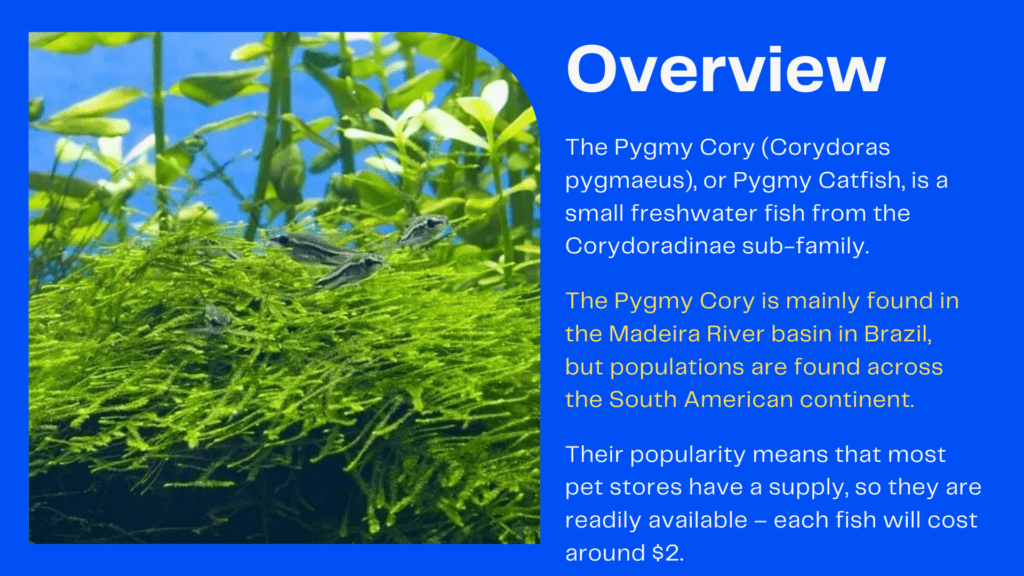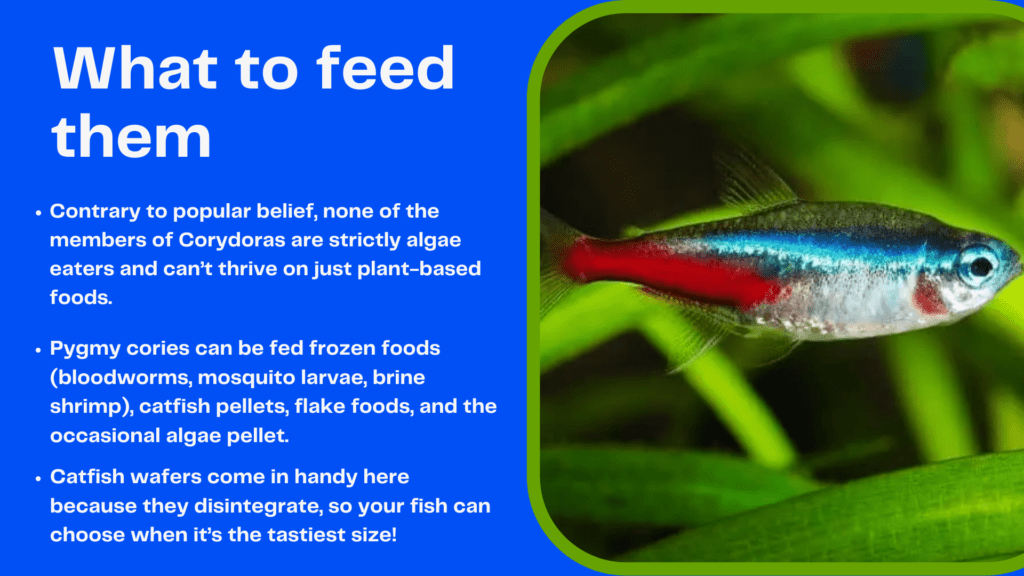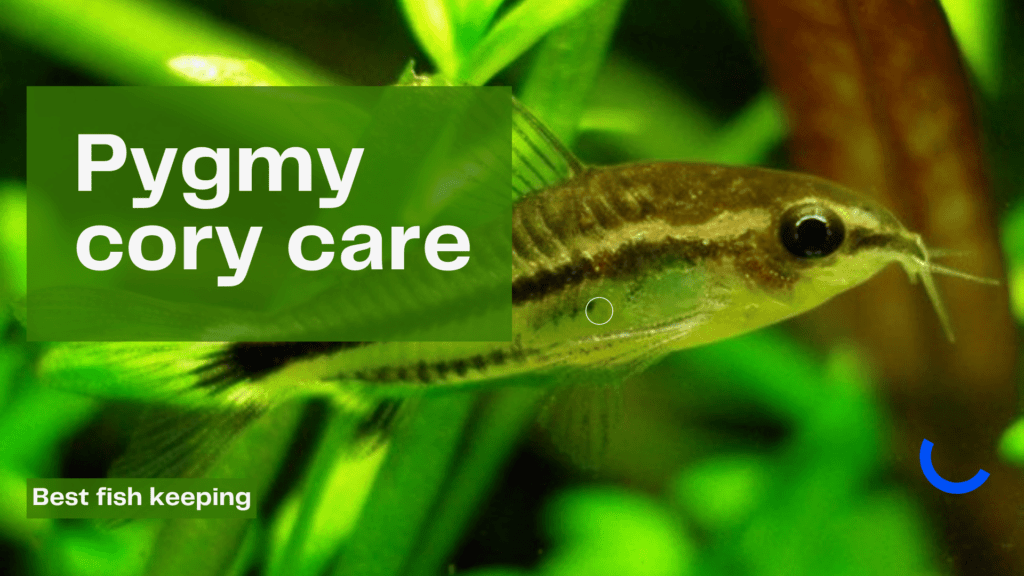Origins of the Pygmy Cory
New species of catfish belonging to the Corydoras genus emerged in recent years. One of them is the Pygmy Corydora (Lat. Corydoras pygmaeus). Because of its small size, this fish is one of the world’s most remarkable creatures.
The first scientific description of the fish species Corydoras pygmaeus was published in 1966 by the German biologist and physician Joachim Knaack. This species of fish was included in the genus Corydoras. The scientific name uses the Latin word pygmaeus, which implies dwarf or pygmy. Corydoras pygmaeus are commonly referred to as Pygmy Corydoras (Pygmy Cory) and Pygmy Catfish. Corydoras pygmaeus is often associated with confused Corydoras hastatus; Indeed, Hastatus was once the only known miniature Corydoras species.
The natural habitat of the pygmy cory
The pygmy Cory is native to South America and is widespread in continental waters: in Peru, on the Nanay River’s tributaries, in Ecuador, on the Aguarico River’s tributaries, and mainly in western Brazil on the tributaries of the river Madeira.
In nature, they are hidden in large quantities in tree roots, peripheral vegetation, and streams.
Overview of Pygmy Cory

The pygmy Cory looks like most Corydoras catfish, except for its size, of course. As its name suggests, we know that the pygmy corie is very small. Females are typically between 2.5 and 3.2 cm in length, while their male counterparts are even smaller and only reach ~ 2 cm. Also, the females are rounder and broader, especially when they are full of eggs.
Pygmy Cory’s body is silver in color with a solid black line that runs horizontally from its snout to its caudal fin. This is accompanied by another thinner black line that penetrates deeper into the body. Its upper part is visibly darker than the lower part.
Newly hatched roasts have vertical stripes on the sides. These gradually fade and are replaced by horizontal bands at the end of their first month.
Black marks are the main differentiator between Pygmy Cory and Corydoras hastatus. Additionally, the Hastatus has black tints on the tail that resemble the black arrowhead that the dwarf Cory lacks.
Pygmy Cory behavior
Pygmy Cories are adorable, peaceful, non-aggressive, and very shy fish. It is best to keep in a common reservoir of small fish species and aggressive. They are usually kept in groups of at least 6, and better still in larger groups of 10 or more preferably (more is always better). They love to swim in schools in the middle and bottom of the reservoir.
Although fish are generally a mid-water resident, they will occasionally descend to burrow into the substrate. Therefore, a fine-grained substrate must be provided so that the fish does not damage its barbel in the process.
Corys are by nature optional air respirators. This means that they can breathe atmospheric air when needed. They have a modified, highly vascularized gut that helps remove oxygen from the air.
This adaptive property helps them survive if their habitat is deprived of oxygen for any reason. Every once in a while in the aquarium, you will see them swimming on the surface to take a deep breath. Your visits to the water surface are more frequent when the reservoir has poor water conditions.
Properties:
- Social: Very
- Active: yes
- Peaceful: yes
Feeding the Pygmy Cory

Feeding the Pygmy Cory is not a problem. In nature, they nibble on the micro-foods they have. Although you can feed a variety of foods in the aquarium, such as:
- Brine shrimp (Artemia salina ),
- Blood worms
If you don’t like live food, there are other options you can explore, such as:
- frozen bloodworms,
- Mosquito larvae,
- Freeze-dried tubifex and black worms.
Pygmies are omnivores and, as such, will enjoy plant-based foods as well. The options range from seaweed wafers and swallowed catfish pellets to commercially prepared green foods. This fish species has no problem ingesting any type of food as the food offered is small enough to fit in the mouth for chewing and digestion.
They also like a natural layer of decaying waste. It may not sound very appealing, but adding a little variety to your diet will also boost your immune system. So give them Indian almond leaves, alder cones, etc.
Some complementary foods to feed your pygmy Corydoras can include blanched zucchini, spinach, peas, and cucumber. Make sure all vegetables put in a tank are proven to be pesticide-free.
Important: Pygmy Cory is not a pushy eater. So if you have other species of fish in your aquarium, they can be challenging to feed. They often avoid jumping in food when there are too many fish. There are several ways to solve this problem. For example, it could be feeding them with small pipes in time or adding their food after dark.
Properties:
- Diet type: omnivorous
- Food preference: seaweed
- Power frequency: every day
Are Corydora pygmy plants safe?
Yes, pygmy Corydoras are entirely harmless to plants. They don’t eat healthy plants in the tank. They just don’t eat healthy, living plant matter.
Plants like mosses will also be beneficial to them. The plane’s structure acts like a spider’s web and captures all the free-floating particles. This creates a natural breeding ground for Dwarf Corydoras as they are small and can go places larger fish cannot. Therefore, they often graze on moss.
Note: The large leafy plants in the lower half of the tank make an excellent hammock for resting and sleeping.
Pygmy Cory care

Pygmies do not tolerate high levels of ammonia, nitrites, and nitrates very well. Therefore, your tank should be driven and fully set up before presenting your Pygmies.
Considering the above points, you need to change 10-25% of the water regularly. However, water changes should be done once or twice a month as pygmies don’t do as well with frequent water chemistry changes.
Another thing to know is the level of bacteria in the substrate. Dwarf catfish cory is prey to the infection bacterial; Hence, you need to take proper preventive measures to reduce this.
Be sure to perform routine water tests, remove food debris, and remove dead or rotten plant material by cleaning and vacuuming the substrate. Also, make sure that the tank water flows sufficiently to no biofilm that will accumulate in the water column as this can disrupt your breathing.
Tank size:
A 40-liter tank should be enough to accommodate 4-10 pygmies. If you want a larger group of catfish, you will need a tank with a larger capacity.
Water parameters:
Temperature: An optimum temperature range of 22-26 ° C should always be maintained.
pH: Although they can adapt to a pH range between 6.0 and 8.0, the cories pygmies will grow best in slightly acidic water with pH levels between 6.5 and 6.9.

Hardness: Soft water is preferable. The Corydoras tolerate conditions of neutral or slightly hard water 2-15 DKH. But that doesn’t mean they have to thrive and be happy.
Lighting: The pygmy cory catfish prefers low to medium lighting conditions. They tend to show higher activity levels when there is a lot of light stressing them out. Floating plants like duckweed can be used to diffuse bright light in the tank.
Substrate:
This species of fish appreciates fine-grained substrates for its daily life. A fine sand/gravel substrate without sharp edges (!) Is it best suited for this purpose. It protects your fish from scratching their sensitive sensory chins when searching for food in the substrate.
Note: I would always choose sand between sand and small round gravel.
Plants and Decorations:
Pygmy Corydoras prefer to be in densely planted ponds with good quality water. Barely decorated tanks without live plants are very stressful and uncomfortable for them.
The tank can be configured in the Amazon biotope style. Use a substrate of fine sand next to saturated soil, add driftwood branches, plants with large leaves, and roots twisted to reproduce your natural house.
Pygmy Breeding
As mentioned earlier, breeding this species of fish is a bit technical. However, it is easier to try dwarf breeding in a tank other than the main tank. Here, the water parameters from the main tank need to be replicated in the new tank, and a sponge filter should be used in place of a cartridge filter to avoid sucking the brood.
Females appear noticeably larger and fatter when ready to breed—storing Cory catfish in a ratio of 2 males to 1 female work best.
The female usually has eggs between the pelvic fins, where the male fertilizes them. After each spawning, the female lays eggs in the tank’s glass, often in an area with high water flow. The couple repeats this process until about 100 eggs are fertilized and attached—these eggs hatch after 3 to 5 days.
Advanced methods to breed the Pygmy Cory
Some experienced aquarists simulate natural processes to achieve better results (e.g., with less infertile eggs). To do it:
- A cooler water change (5.5 ° C) is recommended for fish (male and female) to spawn in the classic “t” position. However, if the water temperature is already between 22 ° C and 25 ° C, the temperature no longer needs to be lowered.
- Peat filtration is also recommended to create soft, acidic water. In nature, it is a sign of the rainy season.
- Adding air stones simulates turbulent flow.
Note: However, if you are a beginner or just don’t want to jump through hoops for optimum playback speed. I can assure you that at some point, the pygmy cororias will appear successfully without any changes in the water.
Although it is not very common, adults can eat these eggs if they are not protected. So you will need to move the eggs from the tank to a new container or move the mature fish instead.
The eggs can also develop fungi in the tank. However, this can be combated by adding methylene blue to the tank water and removing rotten eggs to protect healthy eggs from possible infection.
Feeding the Pygmy Cories Fry
The small fish are almost invisible in the early stages and will absorb your yolk sac to survive.
While pygmy cories Fry, the same foods that eat adults, it is best to the elements following emphasis:
- hatched brine shrimp,
- Micro-worms,
- finely chopped flakes
Tip: You can also squeeze the filter media to feed it.
If you want your Pygmy Cory fry to grow too fast, you need to feed them twice a day and even do 50% water changes twice a week. That way, they cut almost 1.5 inches long in just two months.
Problems with Pygmy Cory

While taking care of Pygmy Cory, you should not rule out the possibility of several illnesses or health problems. Routine tank maintenance practices help combat these conditions, while proper nutrition strengthens the health and immune system of fish to help defend against disease. Some of these diseases include the following:
Skin fins and gills: these are worm-like parasites that attach to fish. On physical examination, these sponges can be challenging to diagnose because they are minimal and almost invisible to the human eye. This disease is caused by overpopulation, high stress, and insufficient water parameters. Common symptoms are itchiness, excess mucus on the skin, and redness of the skin and gills.
Costia: This is a parasite known under Ichthyobodo (protozoa) that thrives in cold water and is often difficult to spot in the early stages. Symptoms include red, gray/white patches on the skin, tight fins, loss of appetite, and itching. An effective and inexpensive way to treat Costia is to use salt. Mix 3-4 grams of salt per liter of water and submerge the affected fish.
Bacterial Infection: Infection is caused by the presence of bacteria in the reservoir. It can be challenging for real bacteria to know, which is causing the damage. A good example is the red dot disease. Symptoms are swelling, red ulcers, red streaks.
This infection can be treated with a broad-spectrum antibiotic. NB: Some suspected bacterial infections may be a fungal infection if they can be treated in combination with Ich X and erythromycin.
Pygmy Cory and the right tank mates
The cories pygmies are peaceful fish that can easily intimidate a friend’s most significant oil. Due to their mouths’ structure, they don’t even bite other fish and never retaliate when intimidated.
Fish:
They will appreciate the presence of other small fish with the same temperament as their tank mates. If only these pygmies were more significant, they would be an ideal community fish.
However, there are plenty of potential teammates to consider. Of all the possible suggestions, my favorites include:
- Otocinclus Catfish,
- Chili Rasboras,
- Lambchop Rasboras,
- Bristlenose Pleco Albino,
- Ember Tetra,
- Panda claw
- Celestial Pearl Danio,
- Guppies,
- Endlers,
- Pencil fish
- Danios zebra
- Choice of cherries.
Be extra careful with betta fish, paradise fish, Siamese algae eaters, and angelfish. They are like all kinds; Some are more aggressive than others.
Some tank mates to avoid are cichlids, goldfish, Jack Dempsey, and the Oscars. They should never be placed in a tank with Pygmy Cory.
Shrimp:
Will Pygmy Cory Eat Dwarf Shrimp? Although Pygmy Cories are not hunters, they are still omnivorous. If baby shrimp are small and can adapt to pygmies’ mouths, there is always a chance that they will try to eat them.
Does this happen very often? No, this is not the case. First, Pygmy Cories buried her head in the sand and stumbled with her eyes closed, half-blind. Second, 1-2 week old shrimp is too big to eat.
I would rate Pygmy Cory as the second-best shrimp safe fish after Otocinclus. However, if you are serious about raising shrimp, you should not leave fish in the aquarium!
Snails:
The cories pygmies are compatible with all freshwater snails. They will do an excellent job finding food particles, plant material, and algae in the lower levels of the tank.
Crabs and crabs:
Not! Keep them all kinds of crabs of river and crabs. You can try to catch Pygmy Cory whenever possible.
Conclusion
Pygmy Corydoras are one of the best beginner fish species for nano tanks.
There are many reasons to be fascinated by this species of fish. At the top of the list is the unique behavior they display in the tank. Additionally, pygmies are easy to care for, attractive, lively, and can coexist peacefully with a wide variety of species.




